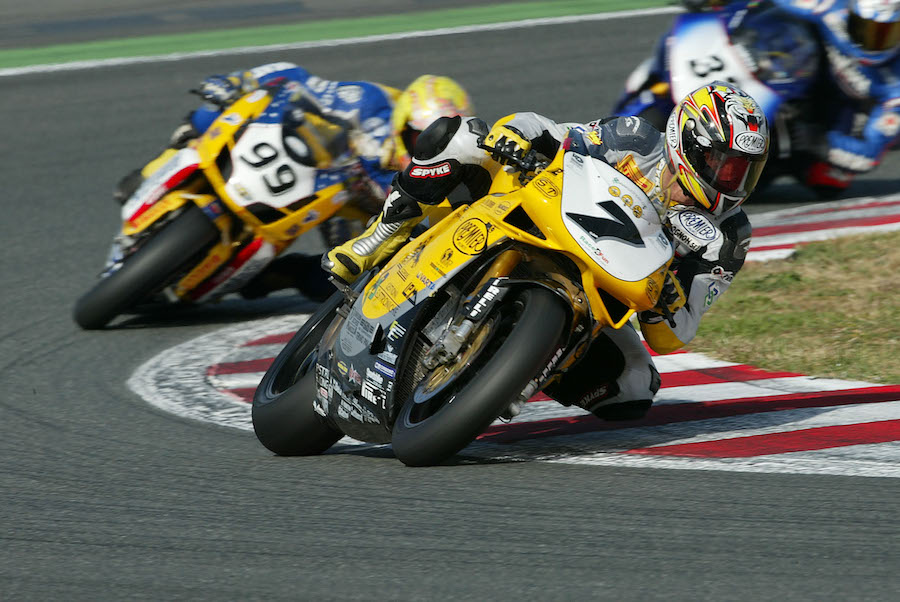Pierfrancesco ‘Frankie’ Chili, the Tiger of Bologna, was a recent visitor to Australia for the International Festival of Speed at Sydney Motorsport Park. These days the former top-level racer and his wife Romina work on the beach in Misano.
“We rent the bed and umbrella for sunshine, and we have some apartments for rent,” he said. “That is what I do mainly in my life now. I really enjoy my retirement, because it’s in the summertime. From April to the end of September it keeps me very busy, and in the winter I have to prepare for the next year.”
In his day, Chili rode more than 400 top-level races, winning a European Championship, five grands prix and 17 World Superbikes races. He competed professionally for two decades, before retiring at age 42 in 2006 due to a broken pelvis.
Chili started racing at 17 on a Malanca 125 and, after completing his national service in the army, dominated the 1985 European 125 Championship on an MBA. Team owner Roberto Gallina brought him to Australia at the end of 1985 to test a 500 Suzuki and that led to four and a half seasons in 500 GP – on a Suzuki, a three-cylinder Honda and then Honda NSR500 V4s.
In 1989 Chili was on Pirelli tyres, which he said lost performance in the middle of the races. But here’s one for trivia buffs … he set fastest race lap in the 1989 Australian GP won by Wayne Gardner.
A huge accident at Spa-Francorchamps in 1990 left him with a broken vertebra, hand and foot, and contributed to the circuit losing GP status. He missed six races and decided to return to racing in 250s.
“There was a team in Italy interested in me and we started again with Pirelli tyres. I made three years with this team – two with Aprilia and then one with Yamaha.”
In 1992 Chili was third in the 250 championship, behind Luca Cadalora and Loris Reggiani.
“My teammate in 1993 was Tetsuya Harada. When we went testing in Japan I saw this guy overtake me twice and ride away. So I stopped and I asked my chief mechanic ‘who is this guy, because he is very fast’. And they told me he was a test rider for Yamaha. They hired him and he won the championship.
“At the end of 1993 I already had a contract for ’94 with the same team, but in February of 1994 they said they had a money problem. It was too late to join another team, the places were already fixed, so I sat down to think about my future. I still wanted to race, so I asked Franco Farnè, one of the very important guys for Ducati, if I could test a Superbike. I didn’t think a Superbike was a racebike, but that was wrong, because when I tested it in Mugello I was really surprised at how well it worked.
“He told me to go to a private team because they were looking for a rider and I started to win races for that private team … once in the first year, twice in the second year and in the third year we win three races. After that I moved to the factory Ducati Team with Troy Corser as teammate, and that year I win five race and I was very strong.
“But unfortunately, we have bad things, a battle with [Carl] Fogarty in Assen in 1998. I lost the second race and I lost the championship there. And after what happened, Ducati say ‘sorry, we cannot continue with you’.”
Independent team owner Francis Batta came to Chili’s rescue for 1999. Batta’s Alstare Corona squad had just been made the official Suzuki team. Chili’s first two meetings on a 750 four saw him 1.5 seconds off the pace and unhappy with the bike. It was a similar story on the first day of Round 3 at Donington Park.
“During the Saturday, my chief mechanic changed the front of the bike quite a lot. And I go out and I said, ‘Oh, I feel very good on the bike’. So I say, ‘Okay, we change the tyre and see what happens’. I put on a new tyre and I go out and I make pole position. I was feeling the change immediately.
“I remember when I was walking to the press conference … people came in front of me and said ‘welcome back’.”
The following year’s Suzuki 750 is one of Chili’s three favourite racebikes, along with the Ducati 998 and the 1990 Honda NSR500.
“I liked the 998 for the bottom-end power. It was quite a heavy bike on the front, but fixed to the road. For Suzuki, after we change it, I liked the stability and the safety it gave to me everywhere. And 1990 Honda because it was a big step from 1988-89 and more fun to ride. I think that was because Eddie Lawson was working on the frame through 1989 and Eddie Lawson, for me, was one of the best riders in the world to fix something like that.”
By Don Cox












